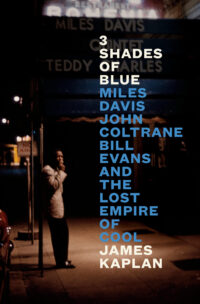True ‘Blue’: James Kaplan ’73 Documents a Key Collaboration in Jazz History

As jazz albums go, Miles Davis’s Kind of Blue represents a high-water mark. The record came at a time of profound musical innovation: bebop had given way to hard bop, a more soulful version of jazz, but Davis wanted to simplify the music and send it in a new direction. The triumvirate of Miles, John Coltrane, and Bill Evans pushed the boundary of what musicians could do, creating a work of hushed magnificence, said James Kaplan ’73.

Kaplan is the author of 3 Shades of Blue: Miles Davis, John Coltrane, Bill Evans, and the Lost Empire of Cool, a book recently published by Penguin Press that tells the story of these three geniuses as men and musicians before, during, and after the landmark 1959 jazz album. “I speak of jazz as an awesome thing,” Kaplan writes in the prologue. “An imperative, an empire. As America’s only native art form, one that boiled forth from a gumbo of ethnic muses in late-nineteenth-century New Orleans and coursed up rivers and railroads and blue highways to Oklahoma City and Kansas City and St. Louis and Chicago and New York City, irresistibly, as young men and women, Black then (very quickly) white, became transfixed by its power and seized on it as an unprecedented form of artistic expression.”
Kaplan graduated with a degree in Studio Art, with plans to go to art school. “Wesleyan gave me the ecstasy of color and of modern abstract painting,” he recalled. But by his own admission, Kaplan was a rebellious student and formal training—which chafed against his passion for abstract art—was not appealing. So, he decided to go another way. “I switched courses once again, and decided to be a writer. I thought if I’m going to be a writer, I should work at the New Yorker,” Kaplan said. “I might as well have decided I was going to be Secretary of State.”
He wrote his most persuasive letter and sent it to the magazine. An editor responded and offered him an interview, which led to a temporary role in the typing pool. He published his first short story in the New Yorker a year later, launching a long career. In addition to fiction and journalism, Kaplan has written well-regarded biographies of Frank Sinatra and Irving Berlin. “I always think of myself as a fiction writer instinctively. My eye and my ear are my most important tools as a writer, whether I’m writing fiction or nonfiction,” Kaplan said.
The first time Kaplan heard Kind of Blue was in 1989 while cramming for an interview with Davis. Vanity Fair was looking for a profile of the notorious jazz legend and Kaplan’s brother convinced an editor that James knew everything about the topic. “In fact, I knew nothing about it,” he said. He went to Tower Records and bought every Miles Davis CD he could find. “Kind of Blue stood out,” Kaplan said. “It was particularly sublime, and it was different from the others. It was different from anything I had heard before.” (Despite Davis’s volatile reputation, Kaplan found a surprise. “It turns out that he could not have been sweeter. He was delightful. He was a pussycat.”)
Years later, when Kaplan was flailing for a book idea, his editor at Penguin Press suggested a portrait of the three creators of the album. When writing the book, Kaplan immersed himself in the music of the era. It was constantly playing as he wrote. He would test himself when listening to recordings to see if he could identify the specific musicians who were playing. “I really had so much to learn,” Kaplan said.
Having already tackled icons like Davis, Sinatra, and Berlin, Kaplan is working on a book about the artistic partnership between John Lennon and Paul McCartney. By approaching his subjects, no matter their stature, with a sense of empathy, Kaplan tries to capture a sense of their greatness, but also their failings. “These are great artists, but they are also human beings,” Kaplan said. “I really like to fully examine who these people are.”

